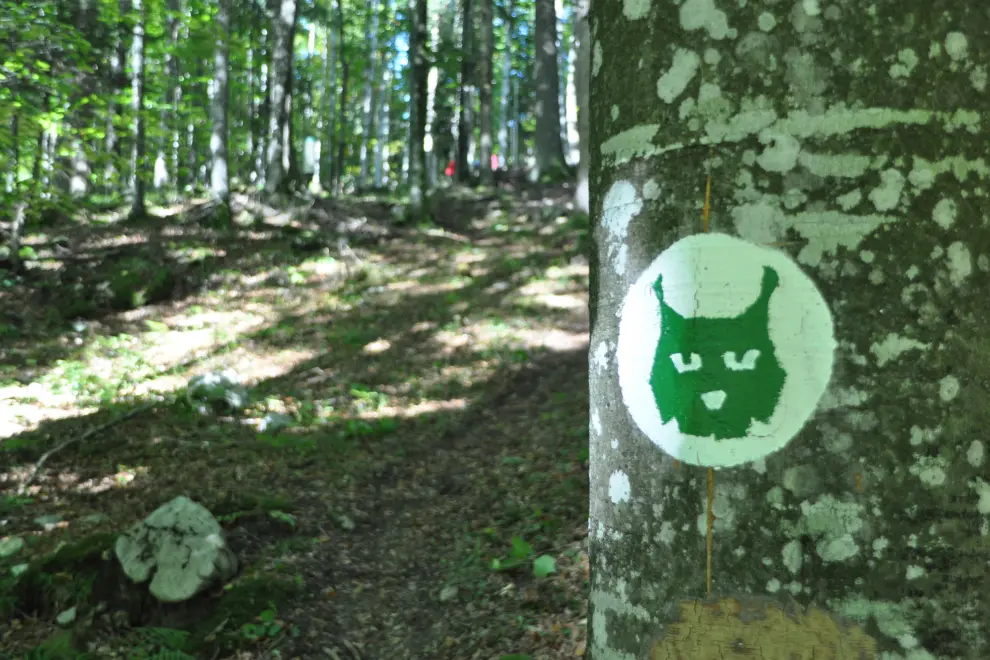The mysteries of forest up close
Slovenia is rich in forests that bustle with wildlife and one way to experience and explore them is by taking one of the many educational trials that criss-cross the country.
There are around 700 nature trails in Slovenia running more than 5,600 kilometres in length. Of these, 93 are forest trails in the domain of Slovenia Forest Service (ZGS). They measure some 500 km in length in total.
Forests cover 58% of Slovenia, the third most forested country in the EU after Sweden and Finland. The trails are a great way to learn how to appreciate and enjoy this treasure and how to preserve it.
"Nature trails are an important tool for popularising forests and forestry and contributing to the development of tourism in rural areas," the ZGS says, noting the health benefits of forest walks.
First trails 50 years ago
First marked educational paths through forests in Slovenia opened in 1947. One of those is a 4.5 km circular path on the Grmada, the western peak of the Šmarna Gora hill above Ljubljana, featuring information boards describing various types of plant species growing along the path.
Another one marking its 50th anniversary this year is the path leading above Bistra Castle near Vrhnika, which is home to the Technical Museum of Slovenia.
"The first paths were designed by foresters, who wanted to spread knowledge about forests and forestry among people in an interesting and attractive way in the forest itself. Forest educational trails have thus become a bridge between nature and society, enabling everyone, regardless of age or background, to learn about the richness, diversity, mystery and importance of forests," the ZGS says.
The ZGS manages 31 trails itself and acts as a partner in a further 62. Most of those 93 can be found on the web portal of the Slovenian Alpine Association along with descriptions and an interactive map.
The longest of these is Roška Pešpot (Rog Hiking Trail), a 64km trail of the pristine forests of Kočevski Rog in the south of the country. Marked with a bear paw symbol in a reference to one of the area's best known inhabitants, the trail is ranked as difficult.
The shortest one, a 350-metre trail called Rinka in the Žalec municipality (NE), only takes about ten minutes to walk. On average the trails are less than five kilometres long.
Best trail competition
Since 2011 the ZGS, the Slovenian Tourist Board and the Hiking and Cycling Association have been holding an annual competition to select best nature trails.
The assessment is based on a number of criteria like how attractive the trail is, how well it is managed and maintained, how accessible and safe it is, its features and guided tours, what message it sends out and how well it is presented.
A total of 14 trails have been selected this year, including the Lynx Trail in the Kočevje region in the south, which opened in September 2021 as part of the Life Lynx conservation project aimed at preventing the extinction of the Dinaric-SE Alpine lynx population.
Featuring nine theme stations and didactic games, the circular trail is intended for everyone interested in the life of Europe's largest wild cat, no matter their age. In 2023 it also won the competition for best theme trail overall.

The Lynx educational trail. Photo: Aleš Kocjan/STA
Marshes, dragon and bear's den
Other best forest trails this year include a short hiking trail along the Hubelj River above the town of Ajdovščina, SW, where visitors learn about the main tree and shrub species of the area, and the Grabnarca water trail in the Radovljica area in NW, affording views of the Karavanke and the Julian Alps.
The Visoko forest nature trail in the Poljane Valley focuses on the wooded countryside, the Blata-Mlake environmental trail near Radomlje in central Slovenia takes hikers through a marshy world and the black alder floodplain forest, and the Mašun forest nature trail in the Snežnik forests, S, includes a visit to a real bear's den.
The Planina-Mirna Gora trail in the Semič municipality, S, takes in a forestry hut with old forestry tools, and the Tk Pav mining trail in the Sevnica area, E, runs past a mighty Douglas fir, while a dragon that used to live in the bowels of the Konjiška Gora range, NE takes visitors along the Dragon's Trail.
The Samostanski Hrib (Monastery Hill) trail in Nazarje combines history and nature, setting off from Vrbovec Castle, home to the local forestry and woodworking museum, it climbs uphill to the Franciscan Monastery and back by the riverside.
The botany and history of the Radlje ob Dravi area, NE, feature on the Stari Grad (Old Castle) trail, while the Ruta nature trail, marked by the image of a chamois, offers views of the Drava River, the Kozjak range and Slovenia's oldest hydro power plant Fala.
The Polanski Log nature trail in the Velika Polana municipality features the black alder as the most typical tree species, and the Resslov Gaj trail above the Debeli Rtič cape focuses on the work of forester and innovator Josef Ressl.
Experiencing nature with all senses
The ZGS holds an open day at selected nature trails every year on Earth Day, 22 April. This year the main event will be held at the Hubelj trail in Ajdovščina.
The 50th anniversary of forest educational trails will be marked by several other events throughout the year, including an international photo competition, debates and exhibitions.
Rather than on opening new trails, the focus today is on renovating and upgrading the existing ones with new content and modern didactic features.
"People experience nature in different ways, and the senses play a particularly important role: sight, hearing, smell, touch and taste. Modern nature trails do not just provide information, but involve visitors in interactive processes of learning about and experiencing nature," the ZGS says.


